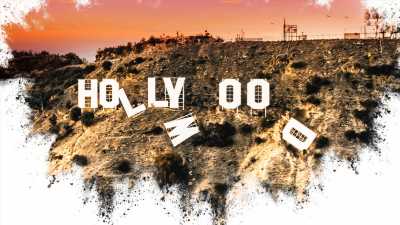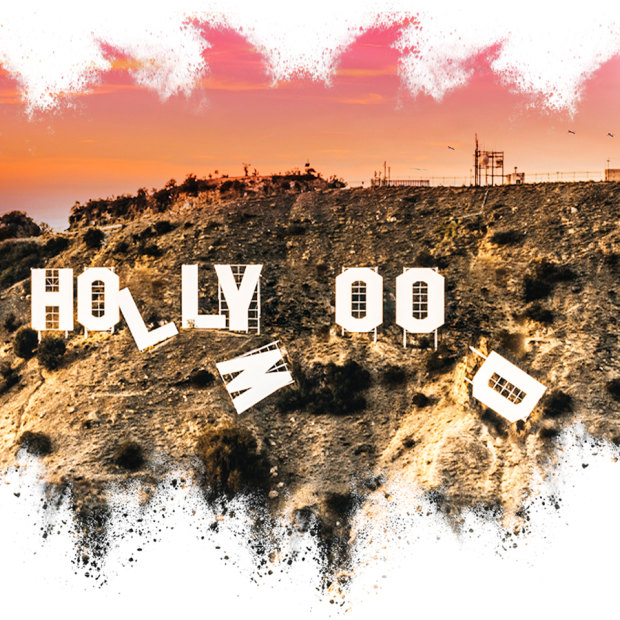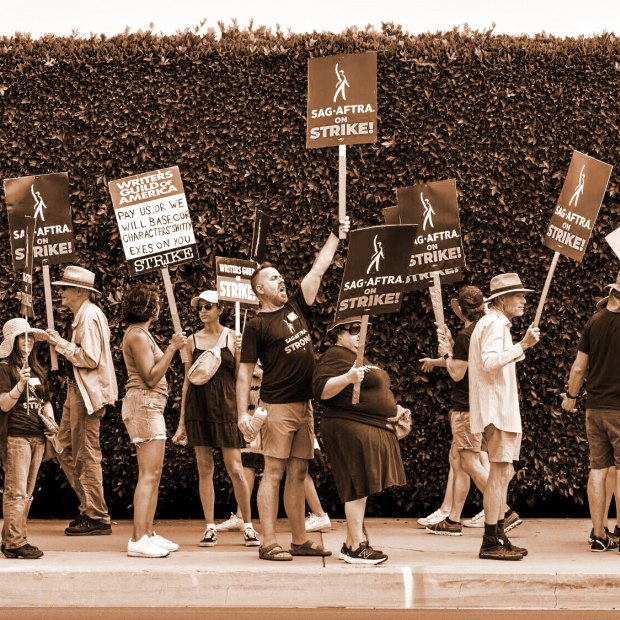US film and TV production has come to a standstill as Hollywood’s actors and writers go on strike. They say this is a moment of truth. What do they want?
Save articles for later
Add articles to your saved list and come back to them any time.
Hollywood is on strike. For the first time since 1960, two of the entertainment industry’s biggest unions – the Writers Guild of America, with around 11,500 members, and the Screen Actors Guild-American Federation of Television and Radio Artists (SAG-AFTRA), with around 160,000 members – have downed tools simultaneously, effectively bringing scripted film and television production to a halt.
Sixty-three years ago, the issue was residuals, the trailing income stream to creators from the broadcast of movies on television. Residual payments are again at the heart of this dispute, but so is the rise of streaming as the dominant force in the industry, and the risk that artificial intelligence might supplant human creatives in the very near future.
That confluence of issues makes this dispute, say the unions, more than just a negotiation over pay and conditions. It’s a moment of existential crisis for writers, actors and other key creatives, and this could be the last chance they have to ensure they have a role to play in the future.
Is that mere picket-line hyperbole, or are we really at a tipping point? If we are, how did we get here? How does this affect production in Australia? And what does it all mean for your favourite shows and movies?
Do changes in technology mark the end of Hollywood as we know it?Credit: Artwork: Marija Ercegovac. Photo: Getty Images
Who’s on strike, and who’s been struck against?
At its simplest, this is an industrial dispute over pay and conditions between two sides: the employers, represented by the Alliance of Motion Picture and Television Producers (the AMPTP), whose members include the broadcasters, streamers, movie studios and major production companies; and the employees, represented by the various screen guilds, two of which – the WGA and SAG-AFTRA – have gone on strike.
The Writers Guild has been on strike since 12.01 am on May 2, the minute after its last three-year agreement with the AMPTP expired without a new deal having been reached. On July 13, the actors joined them on the picket lines.
What’s it all about?
At the top of the writers’ “pattern of demands” was the issue of pay, with the guild demanding the AMPTP “increase minimum compensation significantly to address the devaluation of writing in all areas of television, new media and features”. Translation: in inflation-adjusted terms, increases in writers’ pay have lagged behind inflation for most of the past dozen years, and, coupled with shorter seasons as the work transitions from broadcast TV to streaming, it’s starting to bite.
The guild also wants to break down the distinction between a theatrical (in cinemas) and streaming release for movies (because the type of release impacts on the payments that flow from it) and to “address the issue of mini-rooms”, a strategy employed by the studios to reduce the number of writers on a TV series and the amount of time for which they are employed (effectively turning them into gig workers, much as Australian film and TV writers are).
Way down, almost as an afterthought, was the demand to “regulate use of material produced using artificial intelligence or similar technologies”. But by the time the actors went on strike 10 weeks later, AI had become a lightning-rod issue (more on that later).
Other screen guilds have been vocal in their support for the campaign. Nonetheless, in June the 19,000-member Directors Guild of America reached its own deal with the AMPTP, in which it claimed to have won ground on many of the key issues. With some justification, the directors thought they had struck a blow for everyone else as well. Since 1952, when the directors’ and actors’ guilds reached an agreement with the studios over residual payments for reruns of TV shows – a deal that was then extended to writers after a three-month strike (their first) – when a deal is struck with one of the three major guilds it has been used as the bedrock for deals with the others. This is known as pattern bargaining.
The June deal saw the directors win increased residual payments from the streamers, increases to minimum guaranteed rates of pay (scale), and a vague commitment to not press on with the use of AI without consultation with members. “The parameters of the deal are certainly going to help the other guilds in negotiations,” Oppenheimer director Christopher Nolan told The Hollywood Reporter earlier this month. “It’s very important that all the guilds get a great deal right now. It is a transitional moment. The move to streaming has thrown up all kinds of economic issues with all the guilds and in particular, the writers. And now is the moment that we need to fix those things.”
But Nolan and his fellow directors had underestimated the frustration the other guilds were feeling. In late June, a letter was sent by a bunch of high-profile actors to the leadership of SAG-AFTRA (including president Fran Drescher) affirming their willingness to strike in order to attain a “transformative deal”. Meryl Streep, Julia Louis-Dreyfus, Jennifer Lawrence and Laura Linney were among the big names who put the heat on their union by asserting the make-or-break nature of negotiations. “This is not a moment to meet in the middle, and it’s not an exaggeration to say that the eyes of history are on all of us,” the letter said. “We ask that you push for all the changes we need and the protections we deserve, and make history doing it.”
“The entire business model has been changed by streaming, digital, AI. This is a moment of history that is a moment of truth.”
Passions were further inflamed by a report on trade site Deadline on July 11 in which an anonymous studio executive was quoted saying: “The endgame is to allow things to drag on until union members start losing their apartments and losing their houses.”
On July 14, Drescher positioned the Hollywood strike as the first skirmish in a battle that would soon conscript workers from all industries. “What happens here is important,” she said, “because what’s happening to us is happening across all fields of labour by means of when employers make Wall Street and greed their priority, and they forget about the essential contributors that make the machine run … the entire business model has been changed by streaming, digital, AI. This is a moment of history that is a moment of truth. If we don’t stand tall right now, we are all going to be in trouble.”
Actor Fran Drescher, who is president of SAG-AFTRA, during a press conference announcing the strike on July 13, 2023, in Los Angeles. Credit: AP
Is all Hollywood on strike?
Not exactly. The action impacts on scripted content – film and television and work for new media – made for any company affiliated with the AMPTP. It prevents AWG writers from working for non-AMPTP aligned foreign production companies too, “because of the potential that a non-signatory producer could be used as a subterfuge to have work performed for a struck company”.
Writers can, however, work on spec scripts of their own. But they cannot shop them around.
The actors’ union has been a little more lenient in its interpretation of the idea of a strike, issuing interim agreements to 45 independent film and TV productions (as of July 19) because they had no ties to the AMPTP. Guild members can work on these productions without breaking the strike.
Non-scripted production is also unaffected. The last writers’ strike, in 2007, was a boon for reality TV, which flourished to fill the programming gaps that the three-month shutdown produced. Given some predictions have this strike possibly running to the end of the year, that is likely to happen again.
Picketers outside Paramount Studios in Los Angeles on July 17.Credit: Bloomberg
What does it mean for Australia?
In the short term, it’s a huge blow. The $180 million NBC Universal production Metropolis fell over in June, in part because the scripts weren’t ready and writers could no longer work on them. That has left Docklands Studios Melbourne vacant when it should have been humming, and hundreds of local crew wondering how they are going to fill the void of a good 12 months’ worth of well-paid employment.
The actors’ strike has also prematurely halted two big Hollywood-financed productions in Queensland, the $79 million series Apples Never Fall, starring Annette Bening and Sam Neill, which had been expected to continue into August, and the action movie sequel Mortal Kombat 2, which was to shoot until September.
But there are potentially enhanced opportunities here for Australian-made content to find its way to the American marketplace. In 2007 and 2008, US broadcasters looked beyond their shores for content to fill their schedules, and there is a chance that could happen again.
The landscape is very different now, though, with so much of the content Australia makes (particularly at the high end) already commissioned with foreign markets in mind, and foreign finance part of the package that makes it possible (Deadloch, for instance, while entirely Australian, was financed by Amazon, for a global market). Many Australian production companies have ties to Hollywood, too, so navigating this terrain may not be as simple as it was.
What does it mean for my favourite movies and shows?
The most immediate impact will be felt at the margins, as actors and writers withdraw from the publicity and promotional circus that attends the release of a new film or show. Had SAG-AFTRA gone on strike a few weeks earlier, the world would never have enjoyed (or endured) the barrage of publicity and pinkness around Barbie (not least because producer and star Margot Robbie is a proud supporter of the union). Oppenheimer barely snuck under the wire, with the film’s stars attending, and then leaving, the red carpet premiere in London as bans on promotional activity came into effect.
All of which begs the philosophical question: If a show is released and no actor is around to tell you about it, has it really been released at all?
The effects of this might still be rippling through what makes it to our screens 18 months or two years from now.
The real impact, though, will emerge further down the track. Anything that was still in development or pre-production is on ice, and won’t resume until the strike is over. Anything that was shooting is now on hold. Some of these projects will resume after a delay, some will have shortened seasons or rewritten scripts (or will go into production with scripts that are not as finessed as they otherwise would be), some will fall over entirely. The effects of this might still be rippling through what makes it to our screens 18 months or two years from now.
The impact on cinemas, which have only just begun to emerge from the supply-chain constriction wrought by COVID, could be dire. Just when people were beginning to be drawn back to cinemas by a cluster of blockbusters, along comes another disruption. It might take another year for that to be truly felt, but after three years of knocks it’s the last thing the business needs.
Actor Susan Sarandon, centre, joins a picket line outside the offices of Netflix and Warner Bros in New York City on July 19.Credit: Getty Images
How big a deal is the AI thing?
Much has been made of claims that background actors (or extras) have been offered contracts in which they are asked to consent to being scanned, and to sign away the rights to the use of their digital likeness forever, in return for a single day-rate payment of $US187. The AMPTP issued a denial, claiming the union had “mischaracterised” its “groundbreaking” AI proposals.
But when New York Times reporter Noam Scheiber tweeted last week what he claimed was an extract from “the actual contract” offered by Netflix, there was good reason for aspiring actors – who often start out as extras – to fear the worst. “Player consents to use of Player’s name, voice (actual or simulated), likeness (actual or simulated) and biography,” the clause states, “with no additional compensation to Player, in any and all media and by all technologies and processes now known or hereafter developed, throughout the universe and in perpetuity.”
Little wonder that Australian actor Zac Garred told us the unfettered use of AI poses an existential threat to actors, particularly on the lower rungs (and without real credits, they might never be able to progress to the higher rungs). “The people who are currently graduating from drama schools, who will then be joining the industry in the next few years, are going to be confronted with this existential issue of how do we make a viable living out of an artistic medium that’s trying to eliminate the human element,” he said.
Writers, meanwhile, fear AI could be used to generate story ideas, or even entire screenplays in the case of some formulaic shows such as police procedurals.
“This is only the beginning,” said comedy writer Miranda Berman at a rally in May. “If they take writer’s jobs, they’ll take everybody else’s jobs too. And also in the movies, the robots kill everyone in the end.”
For producers, the ability to create a library of background actors that can be used to populate scenes at a fraction of the cost of hiring dozens or hundreds of real people is understandably appealing. The option of crafting the bones of a script that might need only minimal late-stage input from a real writer is one no exec with an eye on the bottom line could not at least consider. Wherever the parties end up, there is no way AI will simply disappear as a force in the screen industry. The real question is whether it will be a tool used by creatives, or a replacement for them.
On the Hollywood Walk of the Fame in 2007, various unions joined striking Hollywood writers.Credit: Getty Images
But isn’t this mostly about the money?
There are many issues on the table in this dispute, from allowances for hair and make-up to meal breaks to the kind of equipment an actor has to use to record their “self-tape” audition. But when it’s all boiled down, yes, it’s about the money.
Specifically, it’s about base rates of pay, residuals and transparency – and largely, it’s about the streamers.
It’s impossible to overstate the importance of residuals for people in Hollywood. These incredibly complex agreements are at the heart of people’s financial security, their ability to qualify for healthcare coverage (vitally important in the US, where medical expenses can be crippling) and the notion that the people who make something successful should share in the spoils.
In 1952, the guilds struck over the issue of residual payments from reruns of TV shows. In 1960, they struck over residual payments for movies that were broadcast on television. In 2007, the writers’ strike was largely about DVD residuals and compensation for the emerging area of “new media”; content distributed through emerging technologies such as the internet.
That new media is, of course, now the dominant mode of distribution, but as the pendulum has swung away from legacy broadcast media to streaming and other forms of video on demand, the schedule of residual payments has not kept pace.
This industrial dispute is all about the guilds attempting to make up the shortfall in declining income from the generous broadcast residuals by increasing the less-generous payments from streaming. And resistance from the streamers to those efforts.
The average hourly wage of the more than 12,000 actors in Los Angeles, the entertainment capital of the Western world, was $27.89 last year.
It’s the big names on the picket lines – such as former couple Jason Sudeikis and Olivia Wilde (not together, obviously), Susan Sarandon and Adam Scott – who grab the attention of photographers and headline writers. And while they have concerns about the whittling away of their income, the campaign is more about the rank-and-file actors who struggle to get by on a handful of jobs a year, earning scale and relying on the trickle of residuals to boost their income.
According to the US Bureau of Labor Statistics, the average hourly wage of the more than 12,000 actors in Los Angeles, the entertainment capital of the Western world, was $27.89 last year – slightly less than a social worker earns. SAG is pushing for a 19 per cent increase to minimum pay rates over three years; the AMPTP has offered 12.5 per cent.
Of course, most actors are employed only sporadically. According to SAG-AFTRA board member Shaan Sharma (as reported by CNN), only 12.7 per cent of the guild’s members earn enough to clear the $26,470 threshold to qualify for health insurance.
In the glory days of broadcast TV, an actor would be paid a fee for appearing in a show, then if that show was repeated they would get paid that fee again. If it was sold to regional markets (syndication), they would get another fee, and if it was sold to foreign territories or released on home entertainment … well, you get the picture. Score three episodes of a highly popular series that plays and plays, and you’d have a handy trickle of income over many years.
With streamers, there is no regional syndication or home entertainment, and foreign rights are often taken up from the outset. Series tend to be shorter, and while residual payments kick in anywhere from 10 to 90 days after initial broadcast (contracts tend to be individually negotiated), they are paid at a lower rate, taper over the years, and cut out after 13 years. And if a show is pulled from the platform, those payments cease entirely.
The writers are better paid – Variety reported earlier this year that the average income for a Hollywood film and TV writer in 2021 was $US260,000 a year. However, it added, “average earnings do not account for the sizable number of WGA members who, in any given year, earn nothing from writing”.
The bottom line is that the film and television industries rarely provide continuous employment for actors and writers. Residuals are a way of smoothing over the cracks, at least a little, and of sharing the spoils of success on the rare occasions it comes.
It’s little wonder so many in Hollywood, on either side of the trench, think they are worth fighting over.
Fascinating answers to perplexing questions delivered to your inbox every week. Sign up to get our Explainer newsletter here.
If you'd like some expert background on an issue or a news event, drop us a line at [email protected] or [email protected]. Read more explainers here.
Most Viewed in Culture
Source: Read Full Article








